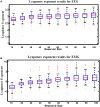Design and Analysis of a Neuromemristive Reservoir Computing Architecture for Biosignal Processing
- PMID: 26869876
- PMCID: PMC4740959
- DOI: 10.3389/fnins.2015.00502
Design and Analysis of a Neuromemristive Reservoir Computing Architecture for Biosignal Processing
Abstract
Reservoir computing (RC) is gaining traction in several signal processing domains, owing to its non-linear stateful computation, spatiotemporal encoding, and reduced training complexity over recurrent neural networks (RNNs). Previous studies have shown the effectiveness of software-based RCs for a wide spectrum of applications. A parallel body of work indicates that realizing RNN architectures using custom integrated circuits and reconfigurable hardware platforms yields significant improvements in power and latency. In this research, we propose a neuromemristive RC architecture, with doubly twisted toroidal structure, that is validated for biosignal processing applications. We exploit the device mismatch to implement the random weight distributions within the reservoir and propose mixed-signal subthreshold circuits for energy efficiency. A comprehensive analysis is performed to compare the efficiency of the neuromemristive RC architecture in both digital(reconfigurable) and subthreshold mixed-signal realizations. Both Electroencephalogram (EEG) and Electromyogram (EMG) biosignal benchmarks are used for validating the RC designs. The proposed RC architecture demonstrated an accuracy of 90 and 84% for epileptic seizure detection and EMG prosthetic finger control, respectively.
Keywords: EMG signal processing; epileptic seizure detection and prediction; memristors; neuromemristive systems; neuromorphic; neuromorphic hardware; process variations; reservoir computing.
Conflict of interest statement
The authors declare that the research was conducted in the absence of any commercial or financial relationships that could be construed as a potential conflict of interest.
Figures















Similar articles
-
Reservoir computing with a random memristor crossbar array.Nanotechnology. 2024 Jul 25;35(41). doi: 10.1088/1361-6528/ad61ee. Nanotechnology. 2024. PMID: 38991518
-
Emerging dynamic memristors for neuromorphic reservoir computing.Nanoscale. 2022 Jan 6;14(2):289-298. doi: 10.1039/d1nr06680c. Nanoscale. 2022. PMID: 34932057 Review.
-
Spiking CMOS-NVM mixed-signal neuromorphic ConvNet with circuit- and training-optimized temporal subsampling.Front Neurosci. 2023 Jul 18;17:1177592. doi: 10.3389/fnins.2023.1177592. eCollection 2023. Front Neurosci. 2023. PMID: 37534034 Free PMC article.
-
Physical reservoirs based on MoS2-HZO integrated ferroelectric field-effect transistors for reservoir computing systems.Nanoscale Horiz. 2024 Apr 29;9(5):752-763. doi: 10.1039/d3nh00524k. Nanoscale Horiz. 2024. PMID: 38465422
-
Synapse-Mimetic Hardware-Implemented Resistive Random-Access Memory for Artificial Neural Network.Sensors (Basel). 2023 Mar 14;23(6):3118. doi: 10.3390/s23063118. Sensors (Basel). 2023. PMID: 36991829 Free PMC article. Review.
Cited by
-
A Dual-Modal Memory Organic Electrochemical Transistor Implementation for Reservoir Computing.Small Sci. 2024 Oct 16;5(1):2400415. doi: 10.1002/smsc.202400415. eCollection 2025 Jan. Small Sci. 2024. PMID: 40212643 Free PMC article.
-
Reservoir computing using dynamic memristors for temporal information processing.Nat Commun. 2017 Dec 19;8(1):2204. doi: 10.1038/s41467-017-02337-y. Nat Commun. 2017. PMID: 29259188 Free PMC article.
-
Neuromorphic computing at scale.Nature. 2025 Jan;637(8047):801-812. doi: 10.1038/s41586-024-08253-8. Epub 2025 Jan 22. Nature. 2025. PMID: 39843589 Review.
-
Adaptive Extreme Edge Computing for Wearable Devices.Front Neurosci. 2021 May 11;15:611300. doi: 10.3389/fnins.2021.611300. eCollection 2021. Front Neurosci. 2021. PMID: 34045939 Free PMC article. Review.
-
sEMG-Based Neural Network Prediction Model Selection of Gesture Fatigue and Dataset Optimization.Comput Intell Neurosci. 2020 Nov 11;2020:8853314. doi: 10.1155/2020/8853314. eCollection 2020. Comput Intell Neurosci. 2020. PMID: 33224188 Free PMC article.
References
-
- Andrzejak R. G., Lehnertz K., Mormann F., Rieke C., David P., Elger C. E. (2001). Indications of nonlinear deterministic and finite-dimensional structures in time series of brain electrical activity: dependence on recording region and brain state. Phys. Rev. E 64:061907. 10.1103/PhysRevE.64.061907 - DOI - PubMed
-
- Buzsaki G. (2006). Rhythms of the Brain. New York, NY: Oxford University Press, Inc. 10.1093/acprof:oso/9780195301069.001.0001 - DOI
LinkOut - more resources
Full Text Sources
Other Literature Sources

